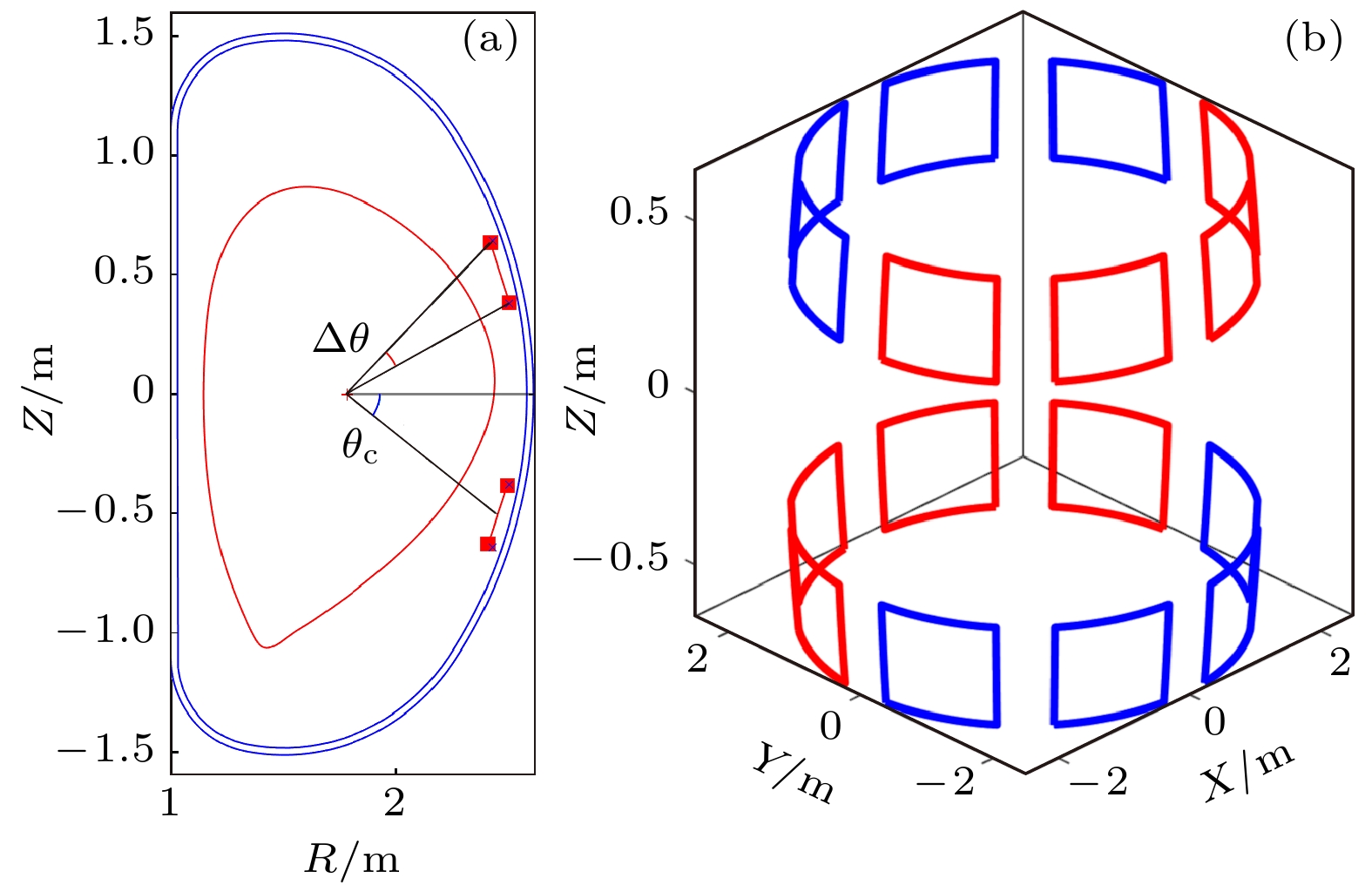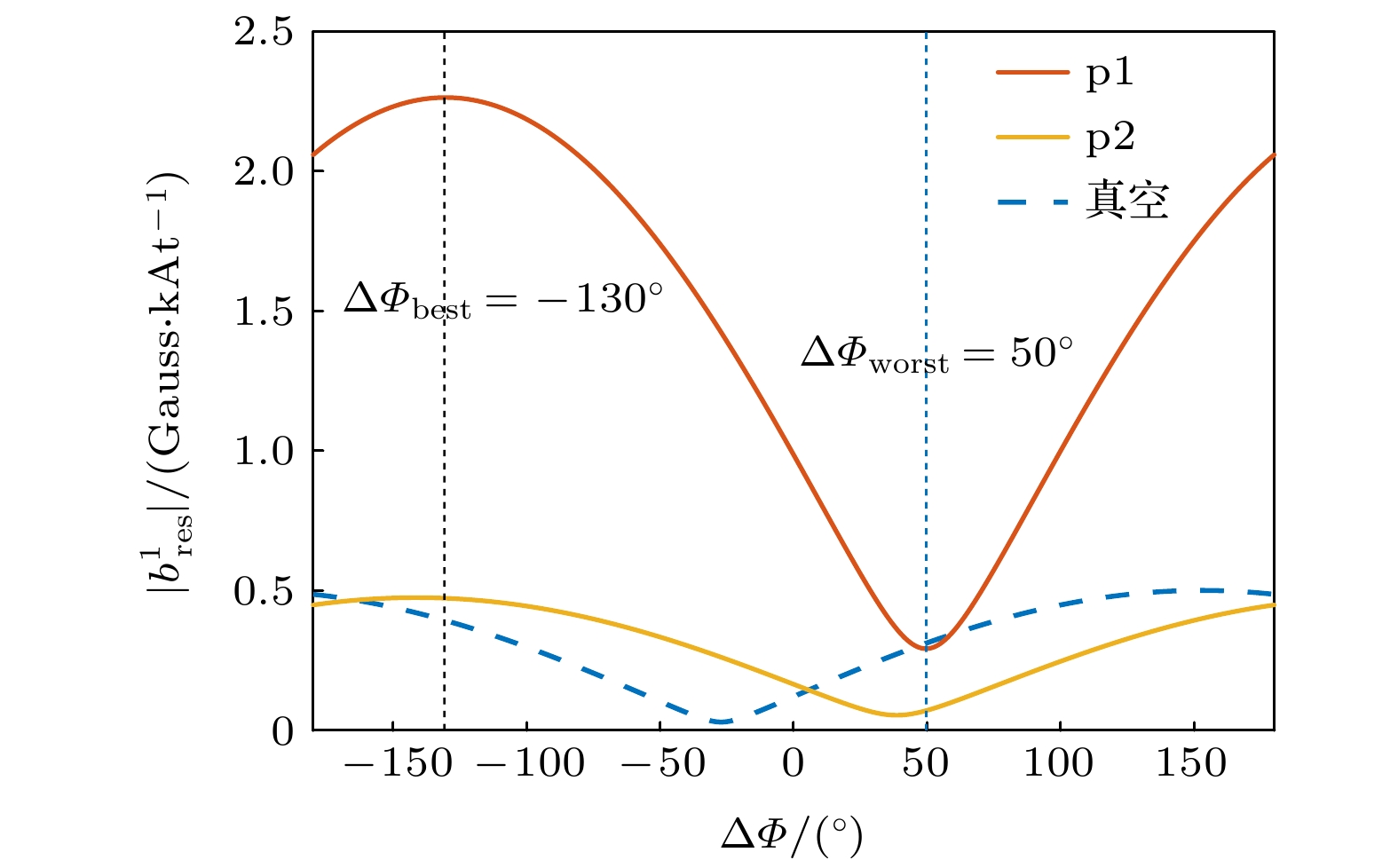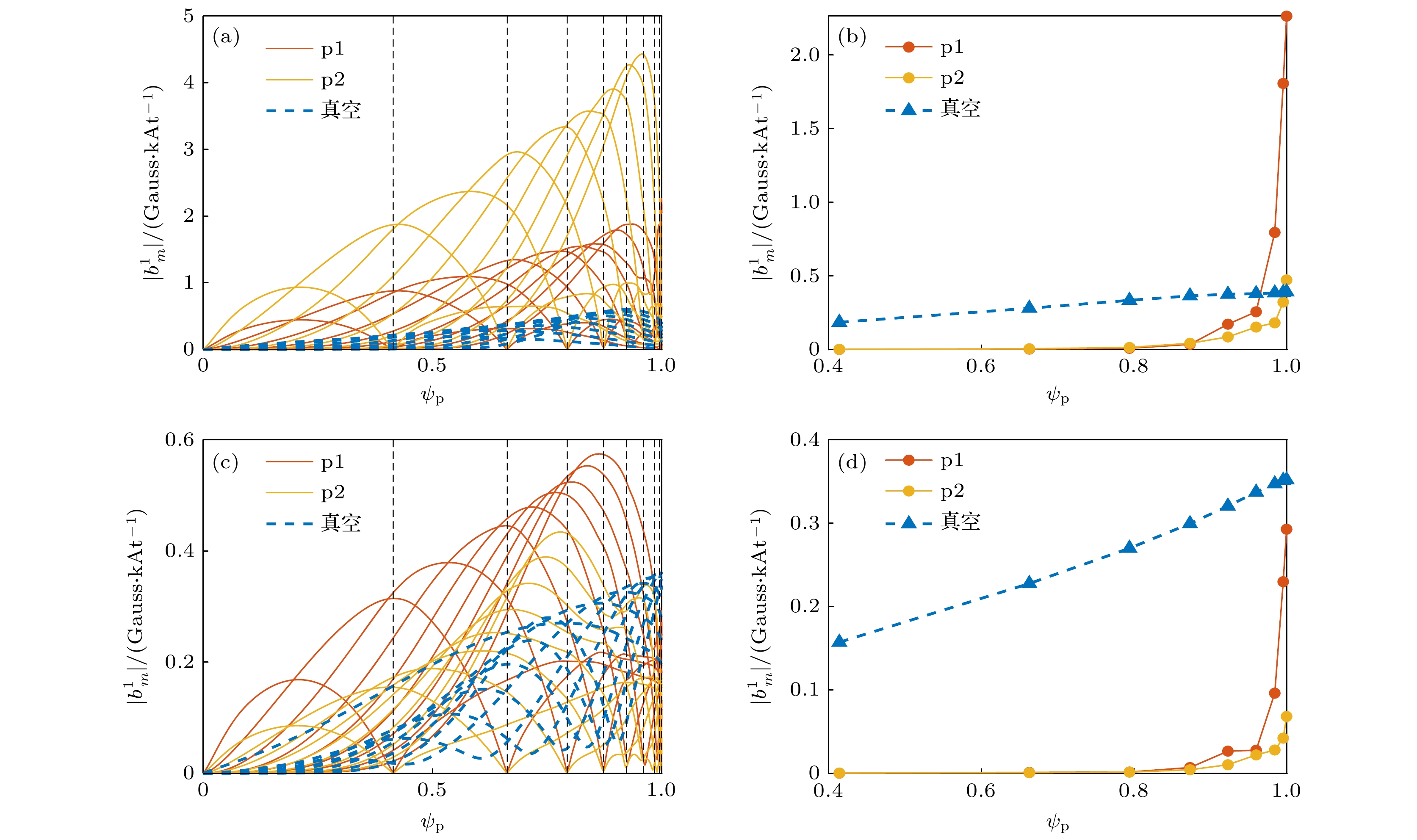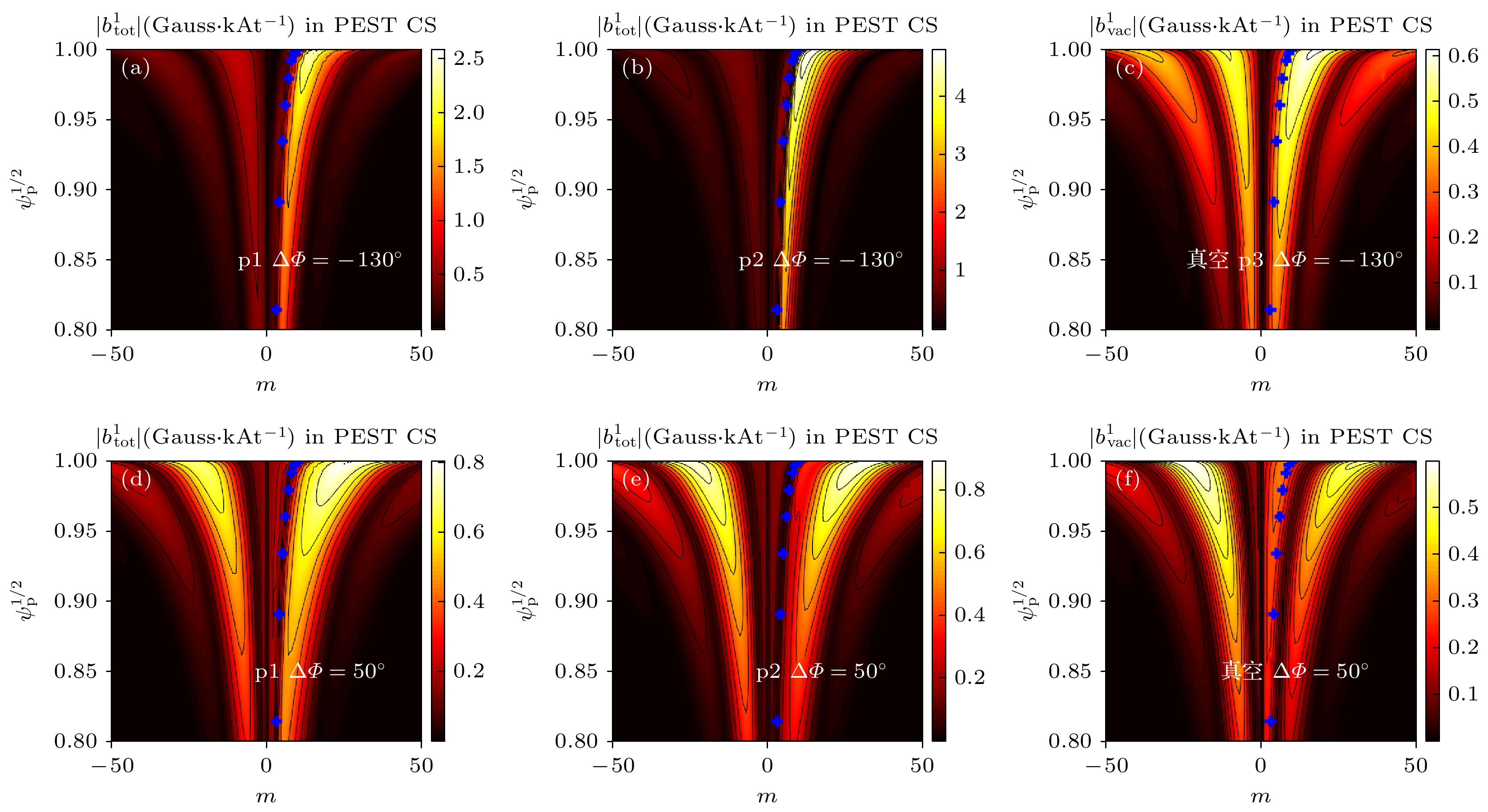-
The type-I edge localized mode (ELM) is a critical event associated with magneto-hydrodynamic(MHD) instabilities occurring in tokamak high-confinement (H-mode) discharges, that leads to huge heat loads on the plasma phasing components (PFC) and may result in material damages. It is important to effectively control large ELMs, in order to ensure safe operation of the future reactor-scale devices such as ITER and DEMO. Resonant magnetic perturbation (RMP) has been experimentally demonstrated to be a mature and robust technique for controlling ELMs. A set of parameters, such as the edge safety factor, the plasma flow, the RMP coil geometry and the spectrum of the applied external field, have been found to play important roles in controlling ELMs by RMP. Furthermore, the plasma pressure is known to affect the plasma response to the RMP field, in particular near the no-wall beta limit. This is because high plasma pressure drives the resonant field amplification of the external field by the plasma response. The ITER 10 MA steady state scenario will be operated near the no-wall stability limit. The new tokamak device HL-2M will also operate in the relatively high-beta regimes. On the other hand, more investigations are still needed to understand the influence of toroidal flow on the high-beta plasma response. This work employs a single fluid toroidal model to compute the plasma RMP response in HL-2M, emphasizing on the roles of two key physical quantities: the plasma resistivity and the toroidal rotation. The former allows penetration of the external RMP field into the plasma, while the latter mainly provides screening effect on the resonant field component. More specifically, the MARS-F code is utilized to study the plasma response to the externally applied n =1 ( n is the toroidal mode number) RMP field for high-beta HL-2M discharges, while varying the plasma toroidal rotation profile. The plasma response is found to (i) substantially modify the poloidal spectrum of the applied vacuum RMP field, (ii) change the amplitude of the resonant radial field amplitude near the plasma edge, and (iii) affect optimal current phasing between the two rows of RMP coils on HL-2M. A sufficiently slow toroidal flow near the plasma edge amplifies the radial field at rational surfaces associated with the perturbation. Since the latter serves as a reliable indicator for controlling the type-I edge localized mode (Type-I ELM) by RMP, varying rotation profile near the plasma edge offers a promising approach to optimize ELM control.
-
Keywords:
- edge localized mode /
- resonant magnetic perturbation /
- toroidal rotation frequency /
- HL-2M tokamak
[1] Zohm H 1996 Plasma Phys. Controlled Fusion 38 105
 Google Scholar
Google Scholar
[2] Connor J W 1998 Plasma Phys. Controlled Fusion 40 531
 Google Scholar
Google Scholar
[3] Loarte A, Saibene G, Sartori R, Becoulet M, Horton L, Eich T, Herrmann A, Laux M, Matthews G, Jachmich S, Asakura N, Chankin A, Leonard A, Porter G, Federici G, Shimada M, Sugihara M, Janeschitz G 2003 J. Nucl. Mater. 313 962
 Google Scholar
Google Scholar
[4] Degeling A W, Martin Y R, Lister J B, Villard L, Dokouka V N, Lukash V E, Khayrutdinov R R 2003 Plasma Phys. Controlled Fusion 45 1637
 Google Scholar
Google Scholar
[5] Evans T E, Moyer R A, Watkins J G, Thomas P R, Osborne T H, Boedo J A, Fenstermacher M E, Finken K H, Groebner R J, Groth M, Harris J, Jackson G L, Haye R J L, Lasnier C J, Schaffer M J, Wang G, Zeng L 2005 J. Nucl. Mater. 337 691
 Google Scholar
Google Scholar
[6] Kirk A, Nardon E, Akers R, Bécoulet M, De Temmerman G, Dudson B, Hnat B, Liu Y Q, Martin R, Tamain P, Taylor D, Team M 2010 Nucl. Fusion 50 034008
 Google Scholar
Google Scholar
[7] Suttrop W, Kirk A, Nazikian R, Leuthold N, Strumberger E, Willensdorfer M, Cavedon M, Dunne M, Fischer R, Fietz S, Fuchs J C, Liu Y Q, McDermott R M, Orain F, Ryan D A, Viezzer E, Team A U, Team D D, Team E F M 2017 Plasma Phys. Controlled Fusion 59 014049
 Google Scholar
Google Scholar
[8] Li L, Liu Y Q, Kirk A, Wang N, Liang Y, Ryan D, Suttrop W, Dunne M, Fischer R, Fuchs J C, Kurzan B, Piovesan P, Willensdorfer M, Zhong F C, Team A U, Team E F M 2016 Nucl. Fusion 56 126007
 Google Scholar
Google Scholar
[9] Hao G Z, Li C Y, Liu Y Q, Chen H T, Wang S, Bai X, Dong G Q, He H D, Zhao Y F, Miao Y T, Zhou L N, Xu J Q, Zhang N, Sun T F, Ji X Q, Liu Y, Zhong W L, Xu M, Duan X R 2021 Nucl. Fusion 61 126031
[10] 陈撷宇, 牟茂淋, 苏春燕, 陈少永, 唐昌建 2020 物理学报 69 195201
 Google Scholar
Google Scholar
Chen X Y, Mou M L, Su C Y, Chen S Y, Tang C J 2020 Acta Phys. Sin. 69 195201
 Google Scholar
Google Scholar
[11] 汪茂泉, 赵晴初 1984 物理学报 33 449
 Google Scholar
Google Scholar
Wang M Q, Zhao J C 1984 Acta Phys. Sin. 33 449
 Google Scholar
Google Scholar
[12] Liu Y, Kirk A, Nardon E 2010 Phys. Plasmas 17 122502
 Google Scholar
Google Scholar
[13] 曹琦琦, 刘悦, 王硕 2021 物理学报 70 045201
 Google Scholar
Google Scholar
Cao Q Q, Liu Y, Wang S 2021 Acta Phys. Sin. 70 045201
 Google Scholar
Google Scholar
[14] Liu Y 2006 Plasma Phys. Controlled Fusion 48 969
 Google Scholar
Google Scholar
[15] 苏春燕, 牟茂淋, 陈少永, 郭文平, 唐昌建 2021 物理学报 70 095207
 Google Scholar
Google Scholar
Su C Y, Mou M L, Chen S Y, Guo W P, Tang J C 2021 Acta Phys. Sin. 70 095207
 Google Scholar
Google Scholar
[16] Liu Y, Ham C J, Kirk A, Li L, Loarte A, Ryan D A, Sun Y, Suttrop W, Yang X, Zhou L 2016 Plasma Phys. Controlled Fusion 58 114005
 Google Scholar
Google Scholar
[17] Xiao J, Sun T, Rao B, Yang Y, Ji X, Li X, Liu Y 2020 Nucl. Eng. Des. 158 111866
 Google Scholar
Google Scholar
[18] Li L, Liu Y Q, Liang Y, Wang N, Luan Q, Zhong F C, Liu Y 2016 Nucl. Fusion 56 092008
 Google Scholar
Google Scholar
[19] Fenstermacher M E, Evans T E, Osborne T H, Schaffer M J, Aldan M P, Moyer R A, Snyder P B, Groebner R J, Jakubowski M, Leonard A W, Schmitz O 2014 Phys. Plasmas 13
[20] Jeon Y M, Park J K, Yoon S W, Ko W H, Lee S G, Lee K D, Yun G S, Nam Y U, Kim W C, Kwak J G, Lee K S, Kim H K, Yang H L 2012 Phys. Rev. Lett. 109 035004
 Google Scholar
Google Scholar
[21] Kamiya K, Asakura N, Boedo J, Eich T, Federici G, Fenstermacher M, Finken K, Herrmann A, Terry J, kirk A, Koch B, Loarte A, Maingi R, Maqueda R, Nardon E, Oyama N, Sartori R 2007 Plasma Phys. Controlled Fusion 49 S43
 Google Scholar
Google Scholar
[22] Li L, Liu Y Q, Wang N, Kirk A, Koslowski H R, Liang Y, Loarte A, Ryan D, Zhong F C 2017 Plasma Phys. Controlled Fusion 59 044005
 Google Scholar
Google Scholar
[23] Liu Y, Kirk A, Li L, In Y, Nazikian R, Sun Y, Suttrop W, Lyons B, Ryan D, Wang S, Yang X, Zhou L, Team E F M 2017 Phys. Plasmas 24 056111
 Google Scholar
Google Scholar
-
图 1 (a) HL-2M装置真空室壁(蓝色)和等离子体边界 (红色)极向截面示意图, 以及RMP线圈极向位置(红色方块); (b) RMP线圈的三维几何位形, 图中方框的红色和蓝色示意RMP线圈不同的电流方向, 这里展示的是环向模数
$ n=1 $ , 相位差为180°的示意图Figure 1. (a) Wall shapes (blue lines) of HL-2M, plasma boundary (red line) and the poloidal location of RMP coils (red squares); (b) geometry of the RMP coils. Red and blue colors indicate the different directions of RMP current flow. (b) shows a
$ n=1 $ case with a toroidal phase difference$\Delta \phi =180°$ .图 2 HL-2M上等离子体平衡的径向剖面 (a) 由
$ {B}_{0}^{2}/{\mu }_{0} $ 归一化的压强剖面; (b) 归一化的密度剖面; (c) 由磁轴处阿尔芬频率归一化的旋转频率剖面‘p1’和‘p2’; (d)安全因子剖面Figure 2. The radial profiles of the HL-2M plasma equilibrium used in this study: (a) The plasma equilibrium pressure normalized by
$ {B}_{0}^{2}/{\mu }_{0} $ ; (b) the normalized plasma density; (c) the plasma toroidal rotation, normalized by the Alfven frequency at the magnetic axis; (d) the safety factor profile.图 3 真空和包含等离子体响应的最后一个有理面处径向扰动场共振分量(
$ {b}_{\mathrm{r}\mathrm{e}\mathrm{s}}^{1} $ )随上下组线圈(环向模数$ n=1 $ )电流相位差$ \Delta \phi $ 的变化Figure 3. The resonant radial field amplitude (
$ {b}_{\mathrm{r}\mathrm{e}\mathrm{s}}^{1} $ ) at the last rational surface of the vacuum RMP field and the total RMP field including the resistive plasma response, while scanning the coil phasing$ \Delta \phi $ for the$ n=1 $ configuration.图 4 (a), (b) 在最优相位差
${\Delta \phi }_{\mathrm{b}\mathrm{e}\mathrm{s}\mathrm{t}}=-130°$ 情况下, 真空RMP($ n=1 $ )场和总的RMP场(考虑了等离子体响应场)共振分量径向分布的对比; (c), (d)对应选取最差相位${{\Delta }\phi }_{\mathrm{w}\mathrm{o}\mathrm{r}\mathrm{s}\mathrm{t}}=50^\circ$ 的对比. (a)和(c)展示的是共振傅里叶分量的径向分布对比, (b)和(d)展示的是有理面处相应共振分量的对比. p1和p2分别表示不同的旋转速度剖面(图2(c)所示)Figure 4. Comparison of the n = 1 vacuum RMP field and the total field perturbation including the plasma response, for the resonant radial field components assuming: (a), (b) The coil phasing
${\Delta \phi }_{\mathrm{b}\mathrm{e}\mathrm{s}\mathrm{t}}=-130°$ ; (c), (d) the coil phasing${{\Delta }\phi }_{\mathrm{w}\mathrm{o}\mathrm{r}\mathrm{s}\mathrm{t}}=50°$ . Shown in left panels are radial profiles of all resonant poloidal harmonics and in right panels the resonant field amplitude at the corresponding rational surfaces indicated by the vertical dashed lines in Figure (a) and Figure (c). p1 and p2 denote the adopted different rotation profiles as shown in Fig. 2(c).图 5 真空径向场和总径向场的不同极向模数傅里叶谐波沿径向的最大振幅比较, 实心为
$m=2, 3, \cdots , 10$ , 的共振谐波, 空心为非共振谐波. p1和p2分别表示不同的旋转速度剖面(图2(c)所示). 这里选取了最优相位${{\Delta }\phi }_{\mathrm{b}\mathrm{e}\mathrm{s}\mathrm{t}}=-130^\circ$ Figure 5. Comparison of the maximal amplitude (along the minor radius) of the poloidal Fourier harmonics of the radial magnetic field for the vacuum and total RMP. Solid and hollow markers denote the resonant (i.e.
$m=2, 3, \cdots , 10$ ) and non-resonant harmonics, respectively. p1 and p2 denote the adopted different rotation profiles as shown in Fig. 2(c).${{\Delta }\phi }_{\mathrm{b}\mathrm{e}\mathrm{s}\mathrm{t}}=-130^\circ$ is used here.图 6 展示了包含(a), (b), (d), (e) 和不包含等离子体响应(c), (f)情况时
$ n=1 $ RMP场在模数(m)和极向磁通($ {\psi }_{\mathrm{p}}^{1/2} $ )二维空间上谱的分布情况. (a)—(c) 选取了相位$\Delta \varphi =-130^\circ$ , (d)—(f) 选取了相位${\Delta }\phi =50^\circ$ . p1和p2分别表示不同的旋转速度剖面(图2(c)所示)Figure 6. Computed poloidal spectra of the n = 1 RMP for the total response radial field including the plasma response (a), (b), (d), (e) and that of the vacuum radial field alone (c), (f), plotted along the poloidal harmonic number m and the plasma radial coordinate. Assumed in Figure (a)–(c) is the coil phasing
$\Delta \phi =-130^\circ$ . And in Figure (d)–(f) the coil phasing${\Delta }\phi =50^\circ$ . p1 and p2 denote the adopted different rotation profiles as shown in Fig. 2(c).图 7 (a) 选取的不同旋转速度剖面; (b) 不同旋转速度剖面情况下, 最后一个有理面处共振径向扰动场(
$ {b}_{\mathrm{r}\mathrm{e}\mathrm{s}}^{1} $ )和$ n=1 $ RMP 线圈电流相位差${\Delta }\phi$ 的依赖关系. p1和p2对应于图2(c)所展示了两种旋转速度剖面. (b)中垂直虚线为p1对应的最优相位差, 实心点标记不同旋转剖面分别对应的最优相位差Figure 7. (a) The chosen various rotation profiles; (b) the resonant radial field amplitude (
$ {b}_{\mathrm{r}\mathrm{e}\mathrm{s}}^{1} $ ) at the last rational surface of the total RMP field as scanning the coil phasing${\Delta }\phi$ for the$ n=1 $ configuration, for choosing different rotation profiles given in Figure (a). p1 and p2 denote the rotation profiles shown in Fig. 2(c). Vertical line denotes the best coil phasing for the p1 case, while the solid dots label the corresponding best coil phasing for the different rotation profiles.图 8 (a) 最后一个有理面处共振径向扰动场(
$ {b}_{\mathrm{r}\mathrm{e}\mathrm{s}}^{1} $ )和边界处等离子体环向旋转之间的依赖关系. 这里选取了${\Delta }\phi =-130^\circ$ ; (b) 展示了(${{\Delta }\phi , \varOmega }_{\mathrm{边}\mathrm{界}}$ )二维参数空间上$ {b}_{\mathrm{r}\mathrm{e}\mathrm{s}}^{1} $ 的分布情况Figure 8. (a) The resonant radial field amplitude (
$ {b}_{\mathrm{r}\mathrm{e}\mathrm{s}}^{1} $ ) at the last rational surface of the total RMP field as varying the plasma toroidal rotation at edge (as shown in Fig. 7).${\Delta }\phi =-130°$ is used; (b) contour plot of$ {b}_{\mathrm{r}\mathrm{e}\mathrm{s}}^{1} $ on the 2-D plane of (${{\Delta }\phi , \varOmega }_{\mathrm{边}\mathrm{界}}$ ). -
[1] Zohm H 1996 Plasma Phys. Controlled Fusion 38 105
 Google Scholar
Google Scholar
[2] Connor J W 1998 Plasma Phys. Controlled Fusion 40 531
 Google Scholar
Google Scholar
[3] Loarte A, Saibene G, Sartori R, Becoulet M, Horton L, Eich T, Herrmann A, Laux M, Matthews G, Jachmich S, Asakura N, Chankin A, Leonard A, Porter G, Federici G, Shimada M, Sugihara M, Janeschitz G 2003 J. Nucl. Mater. 313 962
 Google Scholar
Google Scholar
[4] Degeling A W, Martin Y R, Lister J B, Villard L, Dokouka V N, Lukash V E, Khayrutdinov R R 2003 Plasma Phys. Controlled Fusion 45 1637
 Google Scholar
Google Scholar
[5] Evans T E, Moyer R A, Watkins J G, Thomas P R, Osborne T H, Boedo J A, Fenstermacher M E, Finken K H, Groebner R J, Groth M, Harris J, Jackson G L, Haye R J L, Lasnier C J, Schaffer M J, Wang G, Zeng L 2005 J. Nucl. Mater. 337 691
 Google Scholar
Google Scholar
[6] Kirk A, Nardon E, Akers R, Bécoulet M, De Temmerman G, Dudson B, Hnat B, Liu Y Q, Martin R, Tamain P, Taylor D, Team M 2010 Nucl. Fusion 50 034008
 Google Scholar
Google Scholar
[7] Suttrop W, Kirk A, Nazikian R, Leuthold N, Strumberger E, Willensdorfer M, Cavedon M, Dunne M, Fischer R, Fietz S, Fuchs J C, Liu Y Q, McDermott R M, Orain F, Ryan D A, Viezzer E, Team A U, Team D D, Team E F M 2017 Plasma Phys. Controlled Fusion 59 014049
 Google Scholar
Google Scholar
[8] Li L, Liu Y Q, Kirk A, Wang N, Liang Y, Ryan D, Suttrop W, Dunne M, Fischer R, Fuchs J C, Kurzan B, Piovesan P, Willensdorfer M, Zhong F C, Team A U, Team E F M 2016 Nucl. Fusion 56 126007
 Google Scholar
Google Scholar
[9] Hao G Z, Li C Y, Liu Y Q, Chen H T, Wang S, Bai X, Dong G Q, He H D, Zhao Y F, Miao Y T, Zhou L N, Xu J Q, Zhang N, Sun T F, Ji X Q, Liu Y, Zhong W L, Xu M, Duan X R 2021 Nucl. Fusion 61 126031
[10] 陈撷宇, 牟茂淋, 苏春燕, 陈少永, 唐昌建 2020 物理学报 69 195201
 Google Scholar
Google Scholar
Chen X Y, Mou M L, Su C Y, Chen S Y, Tang C J 2020 Acta Phys. Sin. 69 195201
 Google Scholar
Google Scholar
[11] 汪茂泉, 赵晴初 1984 物理学报 33 449
 Google Scholar
Google Scholar
Wang M Q, Zhao J C 1984 Acta Phys. Sin. 33 449
 Google Scholar
Google Scholar
[12] Liu Y, Kirk A, Nardon E 2010 Phys. Plasmas 17 122502
 Google Scholar
Google Scholar
[13] 曹琦琦, 刘悦, 王硕 2021 物理学报 70 045201
 Google Scholar
Google Scholar
Cao Q Q, Liu Y, Wang S 2021 Acta Phys. Sin. 70 045201
 Google Scholar
Google Scholar
[14] Liu Y 2006 Plasma Phys. Controlled Fusion 48 969
 Google Scholar
Google Scholar
[15] 苏春燕, 牟茂淋, 陈少永, 郭文平, 唐昌建 2021 物理学报 70 095207
 Google Scholar
Google Scholar
Su C Y, Mou M L, Chen S Y, Guo W P, Tang J C 2021 Acta Phys. Sin. 70 095207
 Google Scholar
Google Scholar
[16] Liu Y, Ham C J, Kirk A, Li L, Loarte A, Ryan D A, Sun Y, Suttrop W, Yang X, Zhou L 2016 Plasma Phys. Controlled Fusion 58 114005
 Google Scholar
Google Scholar
[17] Xiao J, Sun T, Rao B, Yang Y, Ji X, Li X, Liu Y 2020 Nucl. Eng. Des. 158 111866
 Google Scholar
Google Scholar
[18] Li L, Liu Y Q, Liang Y, Wang N, Luan Q, Zhong F C, Liu Y 2016 Nucl. Fusion 56 092008
 Google Scholar
Google Scholar
[19] Fenstermacher M E, Evans T E, Osborne T H, Schaffer M J, Aldan M P, Moyer R A, Snyder P B, Groebner R J, Jakubowski M, Leonard A W, Schmitz O 2014 Phys. Plasmas 13
[20] Jeon Y M, Park J K, Yoon S W, Ko W H, Lee S G, Lee K D, Yun G S, Nam Y U, Kim W C, Kwak J G, Lee K S, Kim H K, Yang H L 2012 Phys. Rev. Lett. 109 035004
 Google Scholar
Google Scholar
[21] Kamiya K, Asakura N, Boedo J, Eich T, Federici G, Fenstermacher M, Finken K, Herrmann A, Terry J, kirk A, Koch B, Loarte A, Maingi R, Maqueda R, Nardon E, Oyama N, Sartori R 2007 Plasma Phys. Controlled Fusion 49 S43
 Google Scholar
Google Scholar
[22] Li L, Liu Y Q, Wang N, Kirk A, Koslowski H R, Liang Y, Loarte A, Ryan D, Zhong F C 2017 Plasma Phys. Controlled Fusion 59 044005
 Google Scholar
Google Scholar
[23] Liu Y, Kirk A, Li L, In Y, Nazikian R, Sun Y, Suttrop W, Lyons B, Ryan D, Wang S, Yang X, Zhou L, Team E F M 2017 Phys. Plasmas 24 056111
 Google Scholar
Google Scholar
Catalog
Metrics
- Abstract views: 3157
- PDF Downloads: 71
- Cited By: 0


















 DownLoad:
DownLoad:












































